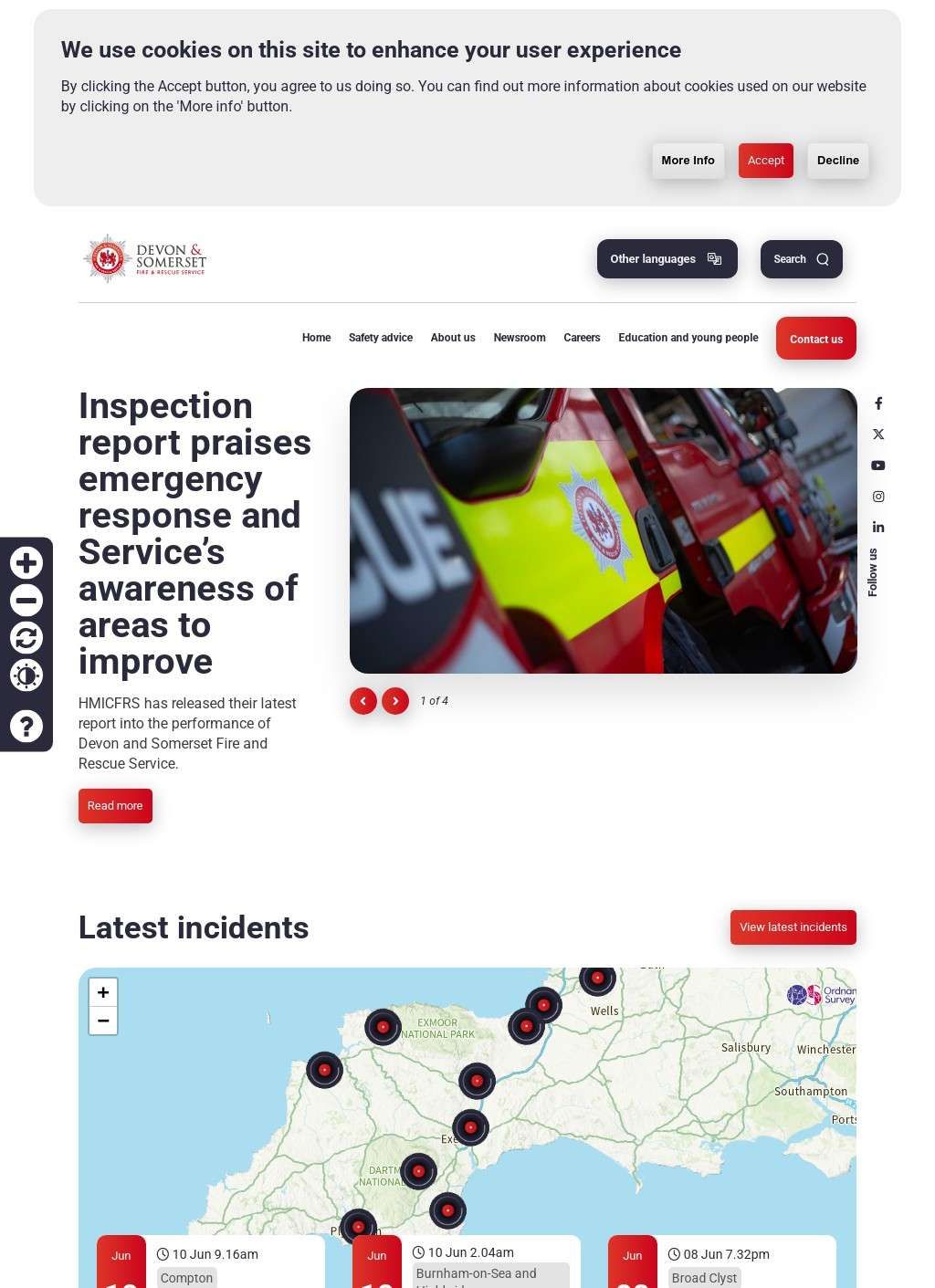Devon and Somerset Fire and Rescue Service operates as the guardian of public safety across two of England's most geographically diverse counties, protecting communities from Ilfracombe's dramatic coastline to the Somerset Levels' flood-prone plains. With 83 fire stations dotted across 3,924 square miles, this merged service (formed in 2007) represents the largest non-metropolitan fire and rescue operation in England. Their crews respond to everything from chip pan fires in Exeter bedsits to massive moorland blazes that can burn for days during dry summers.
The backbone of the service rests on its unique staffing model, with 69 stations operated entirely by on-call firefighters – people who maintain regular jobs but respond when their pagers sound. You'll find builders, farmers, shop workers, and teachers who transform into firefighters within minutes, racing to their local station when emergencies strike. These on-call crews provide vital coverage in rural areas where maintaining full-time stations would prove impossibly expensive. In market towns like Crediton or Wellington, the familiar sound of sirens summoning crews has become part of local life.
Two wholetime stations operate 24/7 in the urban centres, with another ten stations combining wholetime and on-call crews. The service employs over 1,800 staff in total, from frontline firefighters to control room operators who coordinate responses across the vast area. Their fleet includes 121 fire engines plus specialized vehicles for dealing with chemical incidents, water rescues, and major disasters. During summer months, Land Rover-based units access remote locations where standard fire engines can't reach, particularly important when tackling gorse fires on Dartmoor or Exmoor.
Prevention work has increasingly become their focus, with teams visiting homes to fit smoke alarms and provide safety advice. These free home safety visits particularly target vulnerable residents – elderly people living alone, families with young children, or those with mobility problems who might struggle to escape in a fire. Fire crews also deliver hard-hitting safety messages in schools, showing teenagers the devastating consequences of arson or playing with fireworks. Their statistics show this approach works, with fire deaths and injuries declining steadily despite population growth.
Business fire safety forms another crucial responsibility, with specialist officers inspecting everything from tiny B&Bs to massive shopping centres. They ensure escape routes remain clear, fire doors function properly, and staff know evacuation procedures. When new buildings get planned, the service reviews architectural drawings to spot potential problems before construction begins. Hotels, care homes, and hospitals receive particular attention given the challenges of evacuating people who might be asleep, confused, or unable to walk.
The service has pioneered collaborative working with other emergency services, particularly through their co-responder scheme. Nineteen stations host firefighters trained to provide emergency medical care, responding to heart attacks and breathing difficulties when ambulances can't arrive quickly enough. In rural Devon and Somerset, where ambulance response times can stretch due to distances involved, these firefighter-paramedics literally save lives. They carry defibrillators and oxygen equipment, providing vital treatment during those critical first minutes.
Major incidents test the service's capabilities, from the devastating floods that periodically hit Somerset to large factory fires requiring dozens of appliances. The Hinkley Point nuclear power stations demand special preparedness, with dedicated resources and regular exercises ensuring crews can handle radiological emergencies. Their incident command units coordinate complex operations, while environmental protection units prevent pollutants from fires reaching rivers and water supplies. When serious road crashes occur on the M5 or A303, fire crews often arrive first, cutting casualties from wrecked vehicles using hydraulic rescue equipment.
Technology has transformed firefighting operations, though the basic job remains running into danger when others flee. Thermal imaging cameras help crews find casualties in smoke-filled buildings or identify hidden fire spread within structures. GPS systems guide engines to incidents via the quickest routes, crucial when responding to remote farms down unnamed lanes. The control room uses sophisticated mobilization systems that automatically select the nearest available resources, sometimes sending crews from neighboring services when local stations are already committed.
Community engagement extends beyond emergency response, with stations opening doors for charity car washes, Christmas fairs, and educational visits. Fire cadets programmes give young people aged 12-16 chances to learn firefighting skills while developing confidence and discipline. Many current firefighters started as cadets, finding purpose and direction through the programme. Stations often sit at the heart of their communities, particularly in smaller towns where the fire crew represents a visible symbol of public service.
Budget constraints create ongoing challenges, with the service continually seeking efficiency savings while maintaining response standards. Replacing aging fire engines costs over £250,000 per vehicle, while specialist equipment like aerial ladder platforms can exceed £500,000. Training facilities require constant investment to meet evolving risks – crews now train for terrorist incidents, electric vehicle fires, and floods caused by climate change. The service must balance these competing demands while keeping council tax precepts affordable.
Climate change has noticeably impacted operations, with longer, drier summers creating tinderbox conditions on moorland and heathland. Conversely, intense rainfall events trigger flash flooding that sees crews pumping out homes and rescuing stranded motorists. The service has adapted by investing in specialist wildfire units and high-volume pumps, while developing detailed response plans for areas prone to specific risks. They work closely with organizations like the Environment Agency and National Trust to reduce fire risks through controlled burning and creating firebreaks.
Looking at their digital presence, the service maintains an active website providing real-time incident updates, safety advice, and service information. Social media channels share safety messages and celebrate crew achievements, building connections with younger audiences who might not otherwise engage with fire safety. Online reporting allows businesses to check their fire risk assessments and residents to book home safety visits without phone calls. The recruitment section proves particularly valuable for those considering joining as on-call firefighters, explaining commitment levels and training requirements while busting myths about age limits or fitness standards.
